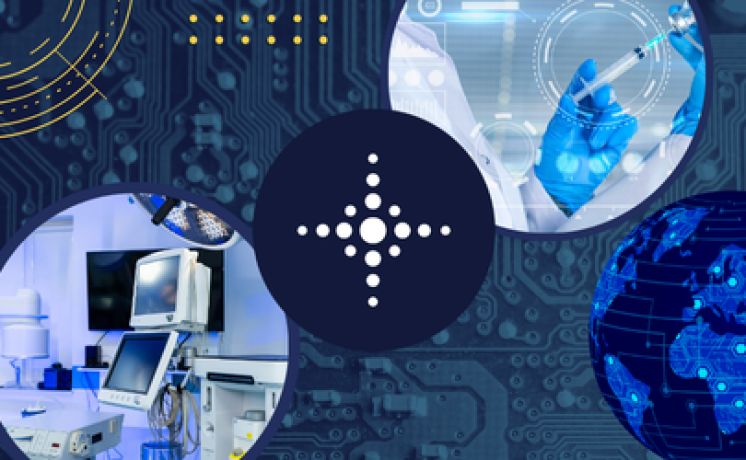AI’s Superpower—and Its Silent Breach Vector. Why the Life Sciences Industry Must Secure MCP Before It Scales.
As life sciences companies shift from AI pilots to production systems, a new standard is changing everything about how models interact with enterprise infrastructure. It’s called the Model Context Protocol (MCP)—and if you haven’t threat-modeled it yet, you’re already behind.
MCP turns large language models (LLMs) into active agents. It lets them call real-time APIs, retrieve documents, query databases, and invoke tools across your environment—all through a universal integration layer. But with that power comes a profound shift in the enterprise risk surface.
Unlike conventional software integrations, MCP introduces non-deterministic agents into the enterprise environment—models that make dynamic decisions, act on behalf of users, and interface with regulated systems like QMS, LIMS, and EHRs. These agents blur the line between tool and operator, forcing security and compliance leaders to rethink how they validate, govern, and monitor AI systems in production.
As of mid-2025, the Model Context Protocol (MCP) has seen rapid adoption, with over 5,000 active MCP servers listed in the Glama MCP Server Directory. According to Aisera, there are more than 115 official production-grade vendor servers, 300+ community-contributed servers, and around 20 built-in reference implementations. MCP SDKs —available in Python, TypeScript, Java, C#, and other languages —are available for download. Major companies including Anthropic, OpenAI, Google DeepMind, Microsoft, and AWS have integrated MCP into their platforms, highlighting its growing importance across the AI ecosystem.
If you’re in biotech, pharma, or MedTech—and especially if you operate under HIPAA, 21 CFR Part 11, or GxP—you need to treat MCP as a privileged execution layer. Because that’s exactly what it is.
What Is MCP and Why Should You Care?
MCP is an open protocol created by Anthropic and adopted by OpenAI and many others. It allows models to interact with tools and data dynamically—without hardcoded logic. Think of it as an AI-native version of HL7 or OPC UA: declarative, tool-agnostic, and deeply extensible.
Instead of fixed integration flows, teams define toolchains—modular units the model can invoke at runtime. These might include a QMS deviation API, a LIMS search tool, or a CDS rules engine.
With MCP, your model becomes a decision-capable interface to those systems. That’s powerful. But also, risky.
MCP is already appearing in:
- Clinical Decision Support: LLMs pulling labs, meds, and diagnoses from FHIR APIs
- Quality Operations: Models summarizing deviations or rewriting SOPs from QMS data
- R&D: AI copilots querying internal protocols or triggering workflow actions in ELNs
This is more than integration. It’s an architectural delegation. The model is now acting as a system operator. The table below compares MCP to traditional API-based integrations.
MCP vs Traditional API
| Aspect | Traditional API Integration | MCP (Model Context Protocol) |
| Execution Agent | Human-triggered or predefined automation | LLM agent acting dynamically at runtime |
| Invocation Logic | Hardcoded workflows or scripts | Language-driven decision-making by the model |
| Tool Access Scope | Narrow, role-based per integration | Broad, context-aware, often with cross-tool orchestration |
| Auditability | Logged in enterprise systems of record | Often absent or inconsistent without custom instrumentation |
| Security Model | Explicit RBAC and pre-approved API keys | Model identity and prompt context drive access; risk of overreach |
| Change Management | Requires deployment cycles for logic updates | Tool behavior can shift with model weight updates or prompt changes |
| Risk Profile | Predictable, limited to defined APIs | Expansive; includes prompt injection, confused deputy, and autonomous data access |
| Compliance Fit (GxP/PHI) | Well understood and validated | Requires new controls for audit, access, and traceability |
How MCP Operates
Here’s how the flow typically works:
- Tool Registration: Tools are defined in a JSON schema and registered with the MCP server.
- Model Prompting: A user sends a prompt to the model (e.g., “Check inventory for batch 2041 in ERP”).
- Tool Invocation: Based on its internal reasoning, the model selects the relevant tool and constructs an RPC call.
- Execution: The MCP server forwards the request to the target system, collects the response, and returns it to the model.
- Response Generation: The model synthesizes a response that incorporates the tool output and returns it to the user.
This mechanism allows AI systems to interact with regulated environments like:
- QMS (Quality Management Systems)
- MES (Manufacturing Execution Systems)
- LIMS (Laboratory Information Management Systems)
- ERP (Enterprise Resource Planning)
Security and Audit Implications
MCP isn’t just a connector—it’s an implicit trust broker. Once the model has access to tools via MCP, it can initiate actions within sensitive enterprise systems. Without strong guardrails, models could retrieve, modify, or even delete regulated content—without clear attribution or auditability. In the context of life sciences, this opens the door to FDA 483 observations, GxP noncompliance, and potential data integrity failures.
In short, MCP redefines how AI systems interact with software ecosystems. Consequently, it redefines how security, compliance, and trust must be engineered into those systems from the outset.
Threat Model
In the MCP paradigm, the model is no longer a passive processor of user input. It becomes a privileged middleman, dynamically orchestrating tool invocations based on language prompts. This introduces several risks:
- Prompt Injection Across Tools
Adversaries can craft malicious prompts that manipulate the model into calling unintended tools, exfiltrating data, or chaining actions that bypass intended business logic. Because prompts are treated as instructions, there is no strict boundary between user intent and system behavior. - Function Over-Permissioning
If tool APIs exposed via MCP are overly permissive, the model may have access far beyond what a human user—or even a trusted automation agent—should. This risk compounds in regulated environments, where a single unauthorized read or write can constitute a compliance failure. - Data Exfiltration
LLMs can summarize, synthesize, or transform sensitive data and return it to users in obfuscated formats. Without context-aware filters or output sanitization, this can include IP, PHI, or controlled documents—violating HIPAA, GxP, or internal data handling rules. - Lack of Built-in Audit Trail
MCP tool calls may not be logged in enterprise-grade systems of record. If a model queries a LIMS system or modifies a quality deviation record, but that action bypasses standard user audit logs, traceability under 21 CFR Part 11 is lost. - Confused Deputy Problem
The model acts on behalf of users, but with broader privileges than any single user might have. If a model is tricked into calling a high-privilege function based on low-trust input, it becomes a confused deputy—executing unauthorized actions without malice or intent.
Why Regulated Systems are at Increased Risk
Frameworks like HIPAA, ALCOA++, and 21 CFR Part 11 depend on:
- Attribution: Who did what, when, and why?
- Auditability: Can the action be independently verified?
- Control: Was the user authorized?
MCP disrupts these assumptions. The model, not the user, performs the action. Unless specifically designed otherwise, there’s no built-in assurance of traceability, review, or constraint.
Examples:
- A model updates a controlled SOP without audit logging. That’s a validation gap.
- It summarizes unreviewed clinical data. That’s an FDA red flag.
- It recommends off-label use based on prompt input. That’s potential SaMD exposure.
In all cases: MCP doesn’t care. It’s just doing what it was asked.
Securing MCP: What’s Required
To deploy MCP safely, organizations need a layered defense strategy:
Policy-Level Controls
- Classify MCP tools by risk (read-only, write-sensitive, clinical-impacting)
- Designate LLMs using MCP as controlled automation layers
- Apply change control and validation procedures equivalent to GxP software
Technical Controls
- Use RBAC-enforcing tool proxies: restrict access by model identity and context
- Maintain a static tool registry: no dynamic tool discovery in production
- Apply a prompt firewall: sanitize inputs to prevent tool manipulation
- Log everything at the API boundary: inputs, outputs, tool version, timestamp, user/model ID
- Scrub outputs: apply NLP filters for PHI, PII, or unsafe recommendations
Operational Controls
- Require formal change control for model weights, tool declarations, and API logic
- Run incident response tabletop drills: simulate model misuse, data leakage, or breach escalation
- Monitor for behavioral anomalies: unusual tool sequences, access outside expected workflows
Governance: MCP Is Not Just a Technical Concern
Security is necessary—but not sufficient. Every MCP-connected model must be governed as a software system of record—subject to the same policies, validations, and lifecycle controls that apply to critical business applications. This includes:
- Versioning and rollback must be enforced across tools, models, and prompts
- Access reviews must cover models, not just human users
- MCP Tool Visibility
Maintain a centralized registry of all MCP-exposed tools, including:- Purpose and system owner
- Input/output schema
- Approved use cases
- Data classification (e.g., PHI, IP, GxP)
- TPRM (Third-Party Risk Management). Vendors may expose MCP-enabled models or tools that directly interact with your systems or data—without traditional software contracts or visibility. Key governance actions include:
- Require vendors to disclose any use of MCP in their AI solutions.
- Incorporate MCP-specific risk questions into security questionnaires.
- Validate that any third-party MCP tool conforms to your access, logging, and compliance standards.
MCP-connected agents are software systems of record. Treat them like it.
Secure-by-Design in Healthcare: An HMCP Blueprint
A leading digital health vendor has demonstrated how MCP can be adapted for regulated healthcare environments through a custom extension known as the Healthcare Model Context Protocol (HMCP). Their implementation showcases how LLM agents can securely interact with clinical data systems—designed to align with HIPAA and 21 CFR Part 11 expectations.
Key architecture elements include:
- OAuth2/OpenID-based identity enforcement
- Tenant-aware data segregation
- End-to-end encryption
- Comprehensive audit logging
- Policy-based rate limiting
Separately, an open-source effort from 2025 demonstrated a CDS prototype powered by MCP and FHIR APIs, using synthetic SMART Health IT sandbox data to explore role-based clinical summarization (arxiv.org). While valuable for early-stage validation, such research setups must evolve toward hardened, production-grade architectures before handling real patient data in regulated environments.
For cybersecurity and compliance leaders in life sciences, architectures in this class define what secure-by-design should look like for MCP deployments. It sets a high bar: if your AI agents touch PHI, GxP data, or patient-facing systems, your controls should meet or exceed this benchmark.
Final Word: Don’t Just Enable It. Secure It.
The Model Context Protocol (MCP) represents a fundamental shift in how AI systems interact with enterprise infrastructure. It transforms large language models from passive responders into active agents—agents that can query systems, trigger workflows, and shape decisions in real time. For life sciences companies, this creates a rare double-edged opportunity: MCP can be a powerful enabler of AI scale, or a silent threat vector embedded in your core systems.
Used correctly, MCP unlocks automation at a level never before possible—streamlining clinical decision support, accelerating quality operations, and enhancing R&D workflows. But that same capability introduces material exposure to data leakage, compliance failure, and security incidents. Unlike traditional APIs or bots, MCP gives models autonomous access to sensitive tools. If those tools are not tightly governed, monitored, and scoped, your AI stack becomes your weakest control surface.
MCP is not inherently dangerous—but it is inherently powerful. It demands a design-first mindset, backed by clear policies, technical guardrails, and governance rigor. If you can’t secure it, don’t deploy it. If you can secure it, you’re not just accelerating AI—you’re leading its safe and compliant adoption in one of the world’s most regulated industries.
At USDM, we help life sciences organizations integrate AI technologies like MCP into regulated environments—without compromising security, compliance, or data integrity. Whether you’re exploring clinical decision support, automating quality processes, or connecting LLMs to GxP systems, we’ll help you build the right guardrails from the start.
If you’re planning or already deploying MCP, let’s talk. We can help you assess the risks, design defensible architectures, and align your AI strategy with regulatory expectations.




